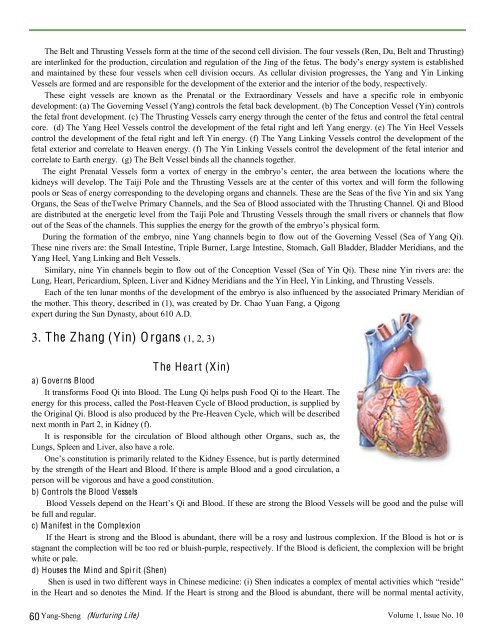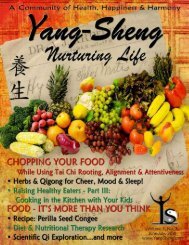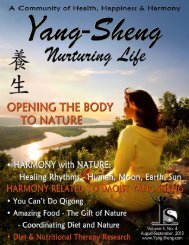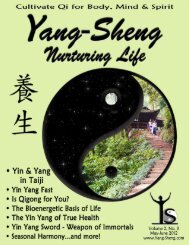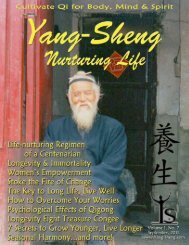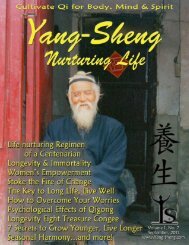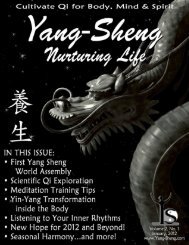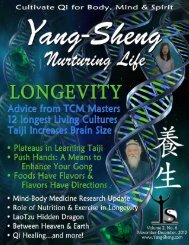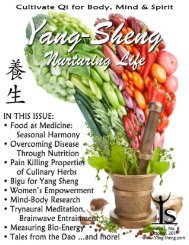Download the December issue of Yang-Sheng as
Download the December issue of Yang-Sheng as
Download the December issue of Yang-Sheng as
You also want an ePaper? Increase the reach of your titles
YUMPU automatically turns print PDFs into web optimized ePapers that Google loves.
The Belt and Thrusting Vessels form at <strong>the</strong> time <strong>of</strong> <strong>the</strong> second cell division. The four vessels (Ren, Du, Belt and Thrusting)<br />
are interlinked for <strong>the</strong> production, circulation and regulation <strong>of</strong> <strong>the</strong> Jing <strong>of</strong> <strong>the</strong> fetus. The body’s energy system is established<br />
and maintained by <strong>the</strong>se four vessels when cell division occurs. As cellular division progresses, <strong>the</strong> <strong>Yang</strong> and Yin Linking<br />
Vessels are formed and are responsible for <strong>the</strong> development <strong>of</strong> <strong>the</strong> exterior and <strong>the</strong> interior <strong>of</strong> <strong>the</strong> body, respectively.<br />
These eight vessels are known <strong>as</strong> <strong>the</strong> Prenatal or <strong>the</strong> Extraordinary Vessels and have a specific role in embyonic<br />
development: (a) The Governing Vessel (<strong>Yang</strong>) controls <strong>the</strong> fetal back development. (b) The Conception Vessel (Yin) controls<br />
<strong>the</strong> fetal front development. (c) The Thrusting Vessels carry energy through <strong>the</strong> center <strong>of</strong> <strong>the</strong> fetus and control <strong>the</strong> fetal central<br />
core. (d) The <strong>Yang</strong> Heel Vessels control <strong>the</strong> development <strong>of</strong> <strong>the</strong> fetal right and left <strong>Yang</strong> energy. (e) The Yin Heel Vessels<br />
control <strong>the</strong> development <strong>of</strong> <strong>the</strong> fetal right and left Yin energy. (f) The <strong>Yang</strong> Linking Vessels control <strong>the</strong> development <strong>of</strong> <strong>the</strong><br />
fetal exterior and correlate to Heaven energy. (f) The Yin Linking Vessels control <strong>the</strong> development <strong>of</strong> <strong>the</strong> fetal interior and<br />
correlate to Earth energy. (g) The Belt Vessel binds all <strong>the</strong> channels toge<strong>the</strong>r.<br />
The eight Prenatal Vessels form a vortex <strong>of</strong> energy in <strong>the</strong> embryo’s center, <strong>the</strong> area between <strong>the</strong> locations where <strong>the</strong><br />
kidneys will develop. The Taiji Pole and <strong>the</strong> Thrusting Vessels are at <strong>the</strong> center <strong>of</strong> this vortex and will form <strong>the</strong> following<br />
pools or Se<strong>as</strong> <strong>of</strong> energy corresponding to <strong>the</strong> developing organs and channels. These are <strong>the</strong> Se<strong>as</strong> <strong>of</strong> <strong>the</strong> five Yin and six <strong>Yang</strong><br />
Organs, <strong>the</strong> Se<strong>as</strong> <strong>of</strong> <strong>the</strong>Twelve Primary Channels, and <strong>the</strong> Sea <strong>of</strong> Blood <strong>as</strong>sociated with <strong>the</strong> Thrusting Channel. Qi and Blood<br />
are distributed at <strong>the</strong> energetic level from <strong>the</strong> Taiji Pole and Thrusting Vessels through <strong>the</strong> small rivers or channels that flow<br />
out <strong>of</strong> <strong>the</strong> Se<strong>as</strong> <strong>of</strong> <strong>the</strong> channels. This supplies <strong>the</strong> energy for <strong>the</strong> growth <strong>of</strong> <strong>the</strong> embryo’s physical form.<br />
During <strong>the</strong> formation <strong>of</strong> <strong>the</strong> embryo, nine <strong>Yang</strong> channels begin to flow out <strong>of</strong> <strong>the</strong> Governing Vessel (Sea <strong>of</strong> <strong>Yang</strong> Qi).<br />
These nine rivers are: <strong>the</strong> Small Intestine, Triple Burner, Large Intestine, Stomach, Gall Bladder, Bladder Meridians, and <strong>the</strong><br />
<strong>Yang</strong> Heel, <strong>Yang</strong> Linking and Belt Vessels.<br />
Similary, nine Yin channels begin to flow out <strong>of</strong> <strong>the</strong> Conception Vessel (Sea <strong>of</strong> Yin Qi). These nine Yin rivers are: <strong>the</strong><br />
Lung, Heart, Pericardium, Spleen, Liver and Kidney Meridians and <strong>the</strong> Yin Heel, Yin Linking, and Thrusting Vessels.<br />
Each <strong>of</strong> <strong>the</strong> ten lunar months <strong>of</strong> <strong>the</strong> development <strong>of</strong> <strong>the</strong> embryo is also influenced by <strong>the</strong> <strong>as</strong>sociated Primary Meridian <strong>of</strong><br />
<strong>the</strong> mo<strong>the</strong>r. This <strong>the</strong>ory, described in (1), w<strong>as</strong> created by Dr. Chao Yuan Fang, a Qigong<br />
expert during <strong>the</strong> Sun Dyn<strong>as</strong>ty, about 610 A.D.<br />
3. The Zhang (Yin) O rgans (1, 2, 3)<br />
The Heart (Xin)<br />
a) Governs Blood<br />
It transforms Food Qi into Blood. The Lung Qi helps push Food Qi to <strong>the</strong> Heart. The<br />
energy for this process, called <strong>the</strong> Post-Heaven Cycle <strong>of</strong> Blood production, is supplied by<br />
<strong>the</strong> Original Qi. Blood is also produced by <strong>the</strong> Pre-Heaven Cycle, which will be described<br />
next month in Part 2, in Kidney (f).<br />
It is responsible for <strong>the</strong> circulation <strong>of</strong> Blood although o<strong>the</strong>r Organs, such <strong>as</strong>, <strong>the</strong><br />
Lungs, Spleen and Liver, also have a role.<br />
One’s constitution is primarily related to <strong>the</strong> Kidney Essence, but is partly determined<br />
by <strong>the</strong> strength <strong>of</strong> <strong>the</strong> Heart and Blood. If <strong>the</strong>re is ample Blood and a good circulation, a<br />
person will be vigorous and have a good constitution.<br />
b) Controls <strong>the</strong> Blood Vessels<br />
Blood Vessels depend on <strong>the</strong> Heart’s Qi and Blood. If <strong>the</strong>se are strong <strong>the</strong> Blood Vessels will be good and <strong>the</strong> pulse will<br />
be full and regular.<br />
c) Manifest in <strong>the</strong> Complexion<br />
If <strong>the</strong> Heart is strong and <strong>the</strong> Blood is abundant, <strong>the</strong>re will be a rosy and lustrous complexion. If <strong>the</strong> Blood is hot or is<br />
stagnant <strong>the</strong> complection will be too red or bluish-purple, respectively. If <strong>the</strong> Blood is deficient, <strong>the</strong> complexion will be bright<br />
white or pale.<br />
d) Houses <strong>the</strong> Mind and Spirit (Shen)<br />
Shen is used in two different ways in Chinese medicine: (i) Shen indicates a complex <strong>of</strong> mental activities which “reside”<br />
in <strong>the</strong> Heart and so denotes <strong>the</strong> Mind. If <strong>the</strong> Heart is strong and <strong>the</strong> Blood is abundant, <strong>the</strong>re will be normal mental activity,<br />
60 <strong>Yang</strong>-<strong>Sheng</strong> (Nurturing Life) Volume 1, Issue No. 10


